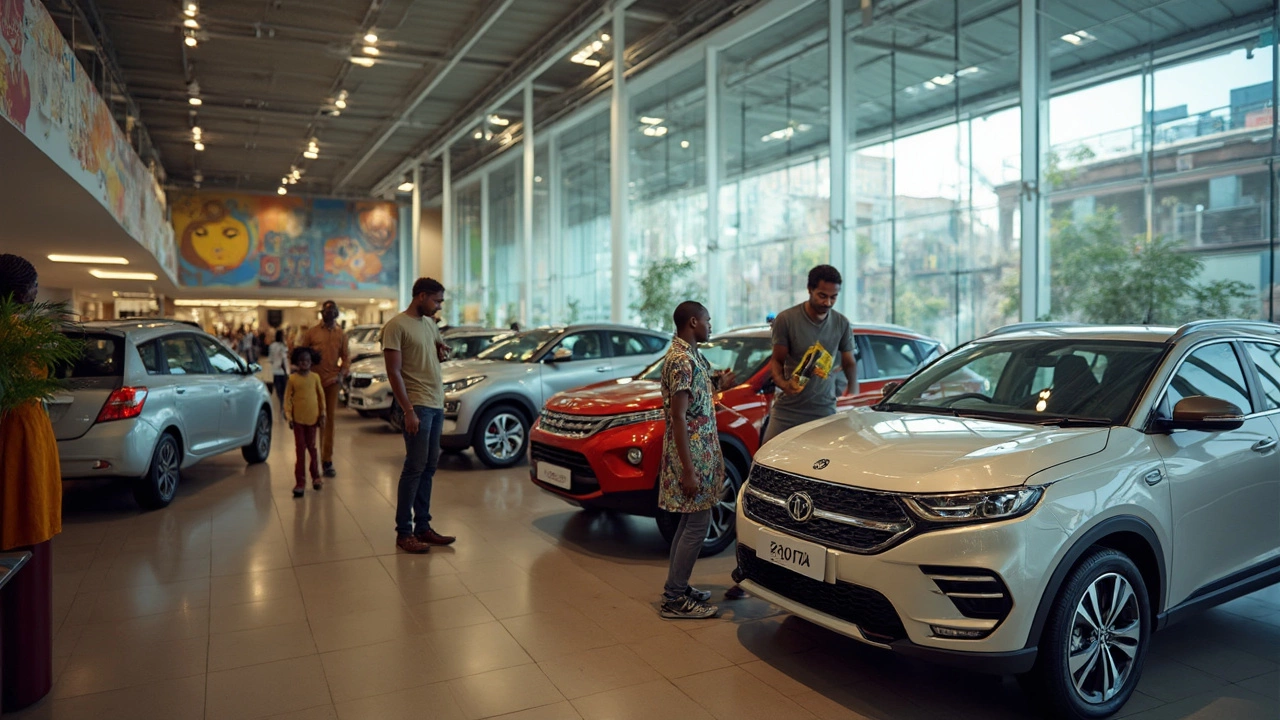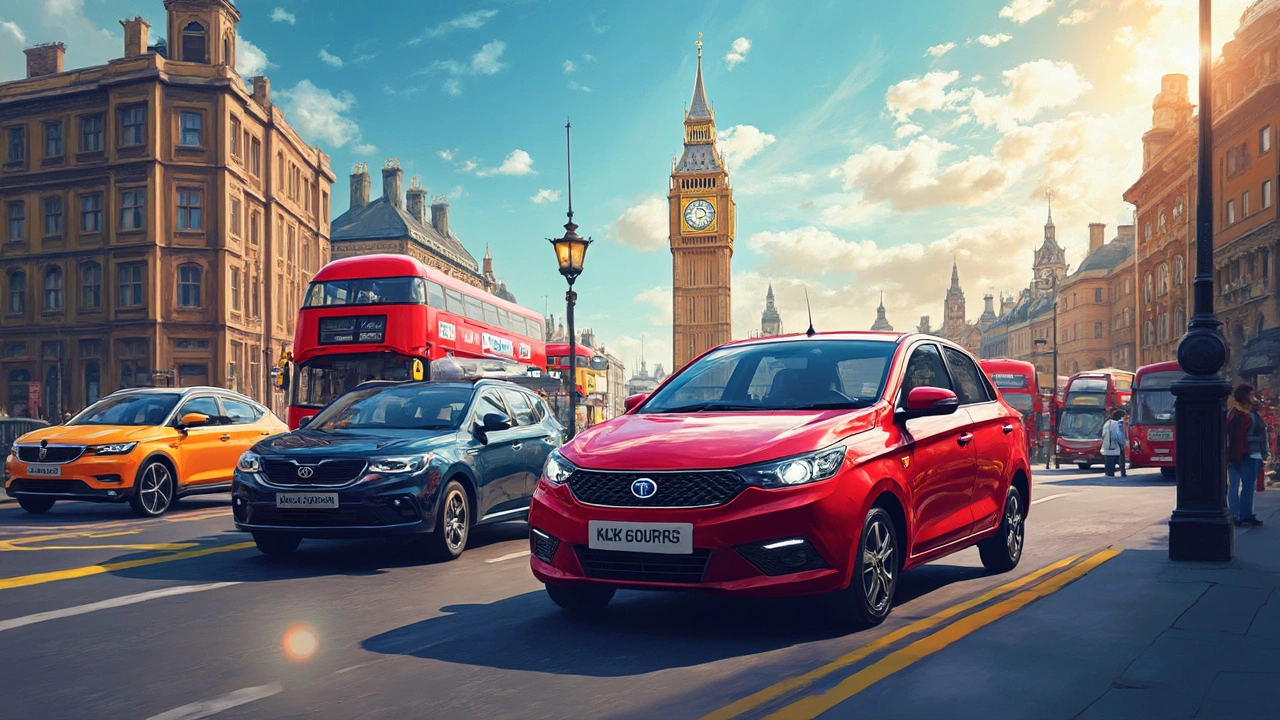Tata Motors isn't just humming along on the streets of India. This giant has spread its wings way beyond, making tracks in several countries around the world. Ever spotted a Tata Nano in Sri Lanka or a Tata Safari cruising in South Africa? Yep, that's how far they’ve reached.
Now, why does Tata Motors have such an appeal abroad? A big draw is their knack for building tough, affordable vehicles. Countries with rough terrains or developing infrastructure seem to appreciate a well-priced ride that can handle a bit of a bump or two. And let's face it, who doesn't love a good deal?
But it's not just about churning out cars and shipping them off. Tata has smartly tailored some of their models to meet local needs, a move that sets them apart from other automakers. Keep an eye on how these strategies help Tata capture a slice of the burgeoning markets. Curious about which markets are booming? Stick around as we take a deeper dive into Tata's international conquest.
- Tata Motors' Global Expansion
- Popular Tata Models Overseas
- Key International Markets
- Challenges and Triumphs
- Future Outlook for Tata Internationally
Tata Motors' Global Expansion
When we talk about Tata Motors' footprint outside India, it's like tracing a map of ambitions and strategic planning. The journey hasn't been an overnight success, but really, nothing worth having ever is.
Footprints in Key Markets
Tata Motors first took steps into the international scene by entering select markets that offered a balance between risk and opportunity. The United Kingdom, for instance, became an initial launchpad, especially after the pivotal acquisition of Jaguar Land Rover back in 2008. This move not only gave Tata Motors access to luxury automobile technology but also helped them establish a stronghold in one of the world’s most competitive automotive markets.
Meanwhile, in Africa, particularly South Africa, Tata’s robust utility vehicles found a receptive audience. The market embraced models that performed well in rugged conditions, matching perfectly with Tata's engineering ethos.
Strategic Alliances and Collaborations
Cementing its international presence further, Tata Motors engaged in strategic alliances. Partnerships with local entities in different countries helped streamline operations and shaped products to meet local demands. For instance, collaborations in Turkey and Thailand offered not only distribution support but also insights into customizing models to local tastes.
Product Line Adaptation and Customization
Understanding that one size doesn't fit all, Tata Motors made smart decisions, adapting their models for specific markets. They've made modifications to existing models, like more fuel-efficient engines for Europe or right-hand drive configurations for Australia and South Africa. It’s these subtle tweaks that have allowed them to compete with global giants who were already entrenched in these regions.
The Road Ahead
While Tata’s international journey is already impressive, the future holds more thrilling pursuits. They’re eyeing Latin America and Southeast Asia with plans tailored to penetrate these emerging markets. With a focus on sustainability and innovation, Tata is setting its sights on electric mobility, a sector expected to change the automotive landscape globally.
| Region | Key Model | Launch Year |
|---|---|---|
| United Kingdom | Jaguar Land Rover | 2008 |
| South Africa | Tata Xenon | 2012 |
| Thailand | Tata Super Ace | 2011 |
As Tata continues its path of expansion, it’s clear that they are not venturing blindly. With well-calculated steps and a good understanding of market dynamics, Tata Motors aims to drive growth and achieve long-lasting global success.
Popular Tata Models Overseas
When it comes to Tata cars gaining popularity outside India, a few standout models have truly made their mark. Let's take a look at some of the top performers that have hit international roads.
Tata Xenon
The Tata Xenon, a sturdy pick-up truck, is a favorite in markets like South Africa and Thailand where demand for reliable utility vehicles is high. Known for its robust build and cost-effectiveness, the Xenon supports both personal and commercial uses.
Tata Tiago
The Tata Tiago, a compact and value-for-money hatchback, has found its way into countries like Nepal and Sri Lanka. Its sleek design, fuel efficiency, and affordable price tag make it an attractive choice for many first-time car buyers or those looking for budget-friendly options.
Tata Harrier
Venturing into the SUV segment, the Tata Harrier has stolen the show in markets like the United Kingdom, thanks to its stylish design and advanced features. The Harrier is designed to offer luxury and comfort without breaking the bank, making it a competitive choice against well-established players in the field.
Tata Safari
An iconic name in India, the Tata Safari has also captured hearts overseas, particularly in the Middle East and Africa. Known for its ruggedness and spacious interior, it serves a multi-purpose role whether used for family outings or adventurous trips.
| Model | Key Markets | Attributes |
|---|---|---|
| Xenon | South Africa, Thailand | Durability, Utility |
| Tiago | Nepal, Sri Lanka | Compact, Economical |
| Harrier | United Kingdom | Stylish, Comfortable |
| Safari | Middle East, Africa | Rugged, Spacious |
Tata Motors continues capturing international interest by introducing vehicles that fit the specific needs and preferences of regional markets. Understanding local consumers and tweaking their offerings accordingly seems to be their winning strategy. It will be exciting to see what other models Tata will roll out globally in the coming years.

Key International Markets
When it comes to spreading their wheels beyond India, Tata Motors has strategically picked markets where it sees real potential. Let's break down where these cars are making waves.
The United Kingdom
Believe it or not, Tata cars have found a respectable home in the UK. Thanks to Tata's acquisition of the luxury British brands Jaguar and Land Rover, there's been a steady flux of sales across the channel. Tata has garnered respect in the UK not just through these brands but with their own models too. Hey, influencing car enthusiasts with Indian innovation!
Africa - Specifically South Africa
Tata’s presence in Africa, especially South Africa, is significant. Here, Tata vehicles are appreciated for their durability and cost-effectiveness – a winning combo when navigating the varying terrains of Africa. From commercial vehicles to passenger cars, Tata has left its mark, making everyday transportation easier and more efficient.
Latin America
Down in Latin America, countries like Argentina and Brazil have opened up their roads to Tata's robust vehicles. The need for affordable, reliable personal and commercial vehicles in these growing economies aligns with what Tata offers. Turns out, good engineering loves good demand!
Emerging Middle Eastern Markets
In the Middle East, Tata is gradually making its way into countries like Saudi Arabia and the UAE. Their utility vehicles are gaining traction, favored by industries that value reliability and robustness without a hefty price tag.
| Region | Main Models | Popularity Reasons |
|---|---|---|
| UK | Jaguar Land Rover, Tata Nexon | Brand reputation, variety |
| South Africa | Tata Xenon, Tata Indica | Durability, affordability |
| Latin America | Tata Tiago, Tata Tigor | Cost-effective, reliable |
| Middle East | Tata Sumo, Tata Safari | Strong utility, affordable pricing |
It's exciting to see how Tata Motors has tailored its approach to fit varying market needs worldwide. As they keep expanding, it'll be interesting to see where Tata sets its sights next!
Challenges and Triumphs
Breaking into international markets isn't all sunshine and smooth highways for Tata Motors. They've hit a few speed bumps along the way. For starters, competing with established car giants like Toyota or Ford in foreign lands is not a walk in the park. These brands are household names and have loyal customer bases that are tough to crack.
Regulatory Hiccups
One of the bigger challenges Tata faces is navigating the maze of regulations in each country. Every region has its own set of rules concerning emissions, safety standards, and vehicle specifications. Tata has to tailor its cars to meet these diverse requirements, which can be costly and complex.
| Market | Regulatory Challenge |
|---|---|
| Europe | Stringent emissions standards |
| Africa | Varied safety regulations |
| Latin America | Import tariffs |
Overcoming Brand Perception
Another hurdle is brand perception. In some markets, Indian cars have historically been tagged as 'cheap options,' not luxury or premium. Tata's challenge was to change this image by emphasizing the quality and durability of their vehicles. Through strategic branding and customer reviews, they've started turning the tide.
Success Stories
Despite these challenges, Tata Motors has had its share of triumphs. In South Africa, for instance, the Tata Safari is quite popular due to its rugged build, which suits the local environment perfectly. In the UK, Tata's acquisition of Jaguar Land Rover played a significant role in establishing a stronger footprint.
Fun fact: did you know that Tata Motors was the first Indian company to develop a car from concept to creation? This pioneering spirit is what keeps them pushing boundaries internationally.
So, while the journey's not been entirely smooth, Tata Motors keeps rolling with the punches, proving there's more grit than glitz in their global journey.

Future Outlook for Tata Internationally
Tata Motors doesn't plan on hitting the brakes anytime soon when it comes to their international ambitions. The automotive giant is revving up its engines to strengthen its position in global markets, leveraging its reputation for reliable and cost-effective vehicles.
Expanding Footprint
One of the key moves Tata Motors is eyeing is increasing its presence in emerging markets. They're looking at countries in Africa and Latin America where there is a growing middle class that desires reliable and affordable transportation solutions. By tailoring products to meet the specific needs of these regions, Tata hopes to keep their competitive edge.
Innovation and Technology
Another big focus for Tata’s future is technology. Electric vehicles (EVs) are the buzz around the globe, and Tata isn't far behind. They're investing heavily in creating environmentally-friendly vehicles. With regulations around emissions tightening worldwide, bringing more EVs to their lineup will help Tata grab more market share and play a role in a sustainable future.
Strategic Alliances
Forming partnerships is also on the cards. Tata Motors understands the importance of strategic alliances to enhance their technological capabilities and expand their market reach. Collaborations could involve sharing technology or co-developing new models optimized for international markets.
Potential Roadblocks
Of course, every journey has its bumps. Tata Motors faces challenges like economic downturns in targeted markets and stiff competition from established players. However, their ability to adapt and innovate gives them a fighting chance to overcome these hurdles.
As it steers towards this ambitious international journey, it's pretty clear that Tata is set on becoming not just a leader within India's automobile sector, but a formidable player on the global stage. So, keep an eye out! The roads might just see more of those familiar 'T' badges worldwide soon.
